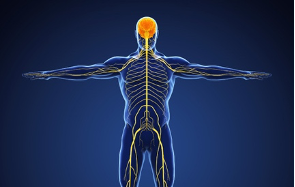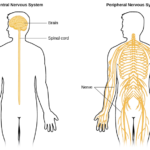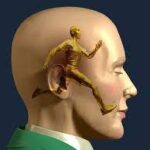
Hi All,
As promised, in this second part, we will get into ways to regulate our nervous system! We will discuss why this is important, what’s the role of the Vagus nerve, and actionable steps that bring us back into a state of homeostasis.
Enjoy (& relax)! 🙂
Nervous System Regulation
The cost of dysregulation, the role of the Vagus nerve, and 8 ways to regulate your nervous system
What happens if we stay dysregulated?
As covered in last month’s article, our bodies aren’t designed to be constantly under stress. If we get stuck in a sympathetic (fight/flight/freeze) state, such as during prolonged periods of stress, our bodies can “fall out of balance”. In the short term, we might feel fatigued and irritable. Over time, the continuous activation of the sympathetic nervous system can lead to severe health problems and favour the onset of diseases by damaging systems in our bodies and reducing overall immune response. It is important that we find back to a parasympathetic (“rest and digest”) state so our bodies can function healthily.
What we didn’t discuss in last month’s article is the importance of a regulated nervous system on our cognitive abilities. You may have heard sentences like “I’m so angry, I can’t think straight,” or “You’re too emotional to judge this,” or “Calm down first, then we can talk”. What are all of these statements getting at?Everyone has a certain stress response threshold, and if this gets crossed, the prefrontal cortex (our centre for logical thinking) shuts down and gets overruled by the limbic system (a set of brain structures involved in emotional responses and behaviour needed for survival). In other words, if we are heavily overstimulated, we cannot think rationally anymore, and our brains go into survival mode. To access our cognitive functions, such as task planning, critical thinking, or decision making, we need to be regulated.

What Nervous System Regulation is NOT
Before we move on, I quickly want to clarify: Having a regulated nervous system does NOT mean always being calm and never getting angry or upset. It simply means being able to return to a balanced state after experiencing stress. Dysregulation means staying stuck in a sympathetic (stress) state and having trouble returning to a parasympathetic state. Symptoms of a dysregulated nervous system can include anxiety, panic attacks, digestive issues, trouble sleeping, constant fatigue, or persistent muscle pain.

“A dysregulated nervous system is the most confining prison that can trap you.
– Chris Warren-Dickins, Psychotherapist & Author of Beyond Your Confines
The Vagus Nerve: A Path To Healing
The vagus nerve is a bundle of nerves leading from the gut, through the heart, to the brain. It’s the longest cranial nerve (we have 12 in total), and its main function is to power the parasympathetic nervous system. The vagus nerve not only connects our brain, heart, and gut, but it is also in communication with every organ and works hard to control inflammation. It alerts the brain to release certain neurotransmitters if something is wrong and influences our physiological responses, such as heart rate, gastrointestinal activity, and immune responses. Scientists have linked vagus nerve dysfunction to obesity, chronic inflammation, depression, anxiety, seizures, abnormally low heart rate, fainting, and gastrointestinal issues.
“It’s safe to say the vagus nerve may be the most important nerve that the majority of people are still unaware of.”
– Dr Nicole LePera, Therapist & founder of The Holistic Psychologist
Dr Nicole LePera continues to stress that the vagal state can be improved naturally through stimulation techniques, which will help improve mood, digestion, and overall well being.
Let’s get into it!
8 Ways To Regulate Your Nervous System & Improve Vagal Tone
Feel free to pick and choose – find out what works for YOU! All roads lead to Rome.
1. Breathwork
Breathwork is one of the most effective ways to stimulate the vagus nerve and influence the parasympathetic nervous system! When we are stressed, our breathing typically becomes small and short, but taking deep breaths signals the body that it is safe to unwind and relax. Current research supports the hypothesis of a causal relationship between the rhythm of our respiration and our perception of pain, stress reduction, and even memory retrieval.
Example breathing techniques:
- Box breathing: inhale for 4 seconds, hold for 4, exhale for 4, hold for 4.
- The 4-7-8 method: inhale for 4 seconds, hold for 7, exhale for 8.
- Wim Hof breathing: taking 30-40 deep breaths and then holding your breath for as long as possible.
- Alternate Nostril Breathing (ANB): breathe in and out through one nostril e.g., the right (while covering the other i.e., left), then change and breathe in and out through the left nostril while covering the right. Repeat for ~10min.
“One breath can shift your brain state”
– Jack Feldman, Neuroscientist
2. Your Voice
- Humming is healing: Humming creates a vibration that stimulates the vagus nerve, which runs through both the larynx and pharynx. It might be unusual for adults to use humming in our daily lives; however, it is highly effective in calming the body. Additionally, it improves heart rate variability.
- Singing, loud laughing, and gargling also activate our vocal cords, which in turn stimulate the vagus nerve. So, let’s listen to J.Lo & “Let’s get loud”! 🎵
3. Movement
Movement is central to our health in many regards (some scientists even argue that it’s the very reason we have a brain!). Here is the kind of movement that helps us regulate our nervous system:
If we are stuck in a stress response, our bodies tense up, so in order to come back to a more balanced state, we want to engage in movement that puts us back into a flow state. For example, dance, practice yoga, or simply shake your body! You might be aware that if prey escapes their predator, once they are safe, they shake their bodies to “digest” the stress that has flooded their body. This also works for humans. So, now we listen to Taylor Swift’s “Shake it off”! 🎵 (This article could have its own Spotify playlist ha).
Before we move on, I want to let you know:
You can now support my work through Ko-fi. If you decide to do so, here is the link: Ko-fi.com/neurosciencemusings
It’s not a requirement but if you choose to support Neuroscience Musings: THANK YOU!
4. Co-regulation
One of my favourite points because it’s so often overlooked! As you know, humans are not made to be isolated but to be interdependent. Co-regulation is the process through which two nervous systems find attunement. For example, if one person is in deep distress but is accompanied by someone who is regulated, the regulated person can help the person in distress to return to homeostasis. This can happen in various ways (always consider the type of relationship and level of trust between the people involved):
- Hugs can heal: hug someone you trust for 30 seconds and feel what happens in your body! If you don’t have someone available, you can also cuddle your pet. Animals have nervous systems too, and we can co-regulate with them as well! (If you neither have a pet nor a person available, a weighted blanket provides the sensation of pressure/touch, which can make the body feel safe.)
- Breathing together:If a person is hyperventilating, it can be helpful to breathe together by facing each other and making eye contact. If you are in a close relationship, you can also place their hand on your chest (and vice versa) to additionally feel the breathing. (Again, only do this with given consent.) Synchronised breathing is also used by professional dancers as part of their training and performance as it strengthens the connection between partners.
- Massages: Massages come with a great number of benefits: they relax our muscles, help our body reduce stress hormones and to release endorphins, improve blood and lymphatic circulation, and overall, help our body move back into a parasympathetic state.
- Be present: similar to the other points, this means giving the distressed person your full attention. However, here your presence can be expressed through, for example, eye contact only and does not require physical touch. This is better suited if you are comforting someone you are not close with.
- Relationship inventory: Relationships are social regulators. Who we are in contact with influences our state of being (e.g., studies have shown that our bodies are more tolerant to pain while a loved one is holding our hand). In contrast, toxic or dysfunctional relationships keep us in a state of perpetual dysregulation. Review your relationships and remember: our nervous systems attune to who we surround ourselves with.
Important note: While we are on the topic of co-regulation, I want to make clear that children cannot self-regulate yet and depend on caregivers to co-regulate with them! One reason why sleep training (i.e., letting babies cry) is damaging to the developing brain is that they simply can’t self-soothe yet and instead go into a shutdown mode /give up. I am in progress of writing a full article on this, but I want to put this out there already as it truly pains me to see this practice still being done today even though it is based on wrong and outdated assumptions.

5. Emotional Freedom Technique (EFT)
You might have heard of Tapping or EFT. It is an evidence-based mind-body practice that impacts the nervous system activity and heart rate variability (HRV) through the stimulation of acupressure points in the body. There is plenty of guided practice content online which can help you to regulate your nervous system.
6. Meditation
This probably comes as no surprise: mediation and interoceptive practices (like journaling) effectively help us to regulate.
“Meditation makes the entire nervous system go into a field of coherence.”
– Deepak Chopra.
7. Connect with Nature
Again, I’m sure no one is surprised: We are part of nature and can greatly benefit from the connection to “mother earth”, whether this is by getting into the sunlight, walking barefoot, looking at water, or (if you want to) hugging trees ha. Nature calms us down! (Unless there’s a spider involved.)
8. Consumption
- Vitamin B levels: B vitamins help with nervous system function and emotional regulation. Deficiencies can cause autonomic dysfunction.
- Fish oil: EPA and EHA lower heart rate, which strengthens vagal tone.
- Aromatherapy: Essential oils such as lavender and bergamot have been shown to increase heart rate variability, which improves vagal tone.

“Look at the nervous system as the key to maximum health.”
– Galen
In Summary: Fix The Foundation First
On more than one occasion, I felt like a broken record when being asked about ways to improve X, Y & Z: How can we be more creative? How can I sleep better? How can we increase motivation? The answers to many different questions seem to be the same repeatedly: meditate, spend time in nature, drink more water, go on walks, etc.
Why is that? Well, all these answers lead us back to the foundation of our well-being and healthy functioning. These practices allow us to return to a regulated nervous system first before moving on and adding additional demands on our body and mind. You have probably heard the term “You can’t pour from an empty cup”, and that is certainly true when we look at maintaining optimal health and long-term success. If we want to show up in our full potential sustainably, we will have to nurture the foundation first.
What do you think?
As always, you can reach me on Instagram @neuroscience.musings or the contact form on the website.
Best regards,
Sarah
References:
- Ashhad, S., Kam, K., Del Negro, C. A., & Feldman, J. L. (2022). Breathing Rhythm and Pattern and Their Influence on Emotion. Annual review of neuroscience, 45, 223–247. https://doi.org/10.1146/annurev-neuro-090121-014424.
- Sinha, A. N., Deepak, D., & Gusain, V. S. (2013). Assessment of the effects of pranayama/alternate nostril breathing on the parasympathetic nervous system in young adults. Journal of clinical and diagnostic research: JCDR, 7(5), 821.https://www.ncbi.nlm.nih.gov/pmc/articles/PMC3681046/
- Pavlov, V. A., & Tracey, K. J. (2012). The vagus nerve and the inflammatory reflex—linking immunity and metabolism. Nature Reviews Endocrinology, 8(12), 743-754. https://www.ncbi.nlm.nih.gov/pmc/articles/PMC4082307/
- https://www.wimhofmethod.com/vagus-nerve-breathing#:~:text=Conscious%20breathing%20exercises%20are%20one,nerve%20breathing%20exercises%20come%20in.
- https://www.psychologytoday.com/gb/basics/synesthesia
- https://www.flowly.world/post/hum-for-your-health-why-humming-is-so-healing-how-to-do-it
- https://www.calm.com/blog/how-to-regulate-nervous-system
- https://theholisticpsychologist.com/vagus_nerve_a_path-to-healing/
- https://positivepsychology.com/nervous-system-regulation/#techniques-for-nervous-system-regulation
- https://nickwolny.com/brene-brown-quote
- https://jennynurick.com/why-co-regulation-is-important/


